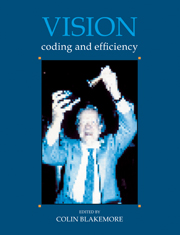Book contents
- Frontmatter
- Contents
- List of Contributors
- Preface
- Reply
- Acknowledgements
- Concepts of coding and efficiency
- Efficiency of the visual pathway
- Colour
- Brightness, adaptation and contrast
- Development of vision
- Depth and texture
- Motion
- 30 The motion pathways of the visual cortex
- 31 Interactions between motion, depth, color and form: the utilitarian theory of perception
- From image to object
- Index
31 - Interactions between motion, depth, color and form: the utilitarian theory of perception
Published online by Cambridge University Press: 05 May 2010
- Frontmatter
- Contents
- List of Contributors
- Preface
- Reply
- Acknowledgements
- Concepts of coding and efficiency
- Efficiency of the visual pathway
- Colour
- Brightness, adaptation and contrast
- Development of vision
- Depth and texture
- Motion
- 30 The motion pathways of the visual cortex
- 31 Interactions between motion, depth, color and form: the utilitarian theory of perception
- From image to object
- Index
Summary
Introduction: theories of perception
If you examine the history of ideas on perception during the last century or so you will notice that there have been three major trends in thinking:
Perception as unconscious inference. This view emphasizes that the visual image is inherently ambiguous and that the perceptual apparatus resolves ambiguities by using ‘intelligent’ processes that resemble conscious reasoning. The idea was originally put forward by Helmholtz (1867) and has more recently been revived by Gregory (1970) and Rock (1983).
Direct perception. Emphasizes the richness of the visual input and argues that ambiguity exists only in contrived laboratory situations but not in the ‘real world’. A vast amount of information is implicit in the visual image and perception is achieved not by making this information explicit but by direct ‘resonance’. Unfortunately, it is never clearly specified how or where in the brain this resonance is supposed to occur.
[…]
- Type
- Chapter
- Information
- VisionCoding and Efficiency, pp. 346 - 360Publisher: Cambridge University PressPrint publication year: 1991
- 38
- Cited by



